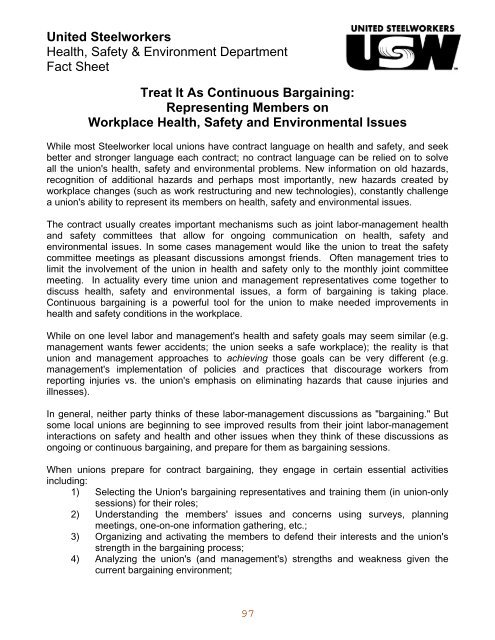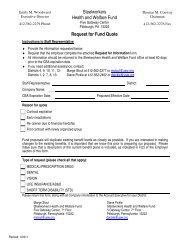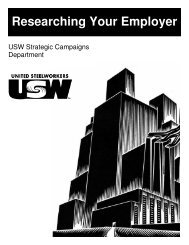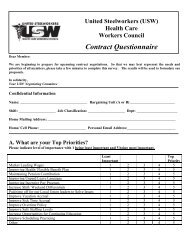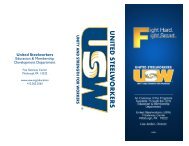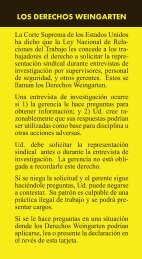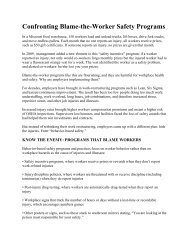Union Approach to Health and Safety: - United Steelworkers
Union Approach to Health and Safety: - United Steelworkers
Union Approach to Health and Safety: - United Steelworkers
You also want an ePaper? Increase the reach of your titles
YUMPU automatically turns print PDFs into web optimized ePapers that Google loves.
<strong>United</strong> <strong>Steelworkers</strong><br />
<strong>Health</strong>, <strong>Safety</strong> & Environment Department<br />
Fact Sheet<br />
Treat It As Continuous Bargaining:<br />
Representing Members on<br />
Workplace <strong>Health</strong>, <strong>Safety</strong> <strong>and</strong> Environmental Issues<br />
While most Steelworker local unions have contract language on health <strong>and</strong> safety, <strong>and</strong> seek<br />
better <strong>and</strong> stronger language each contract; no contract language can be relied on <strong>to</strong> solve<br />
all the union's health, safety <strong>and</strong> environmental problems. New information on old hazards,<br />
recognition of additional hazards <strong>and</strong> perhaps most importantly, new hazards created by<br />
workplace changes (such as work restructuring <strong>and</strong> new technologies), constantly challenge<br />
a union's ability <strong>to</strong> represent its members on health, safety <strong>and</strong> environmental issues.<br />
The contract usually creates important mechanisms such as joint labor-management health<br />
<strong>and</strong> safety committees that allow for ongoing communication on health, safety <strong>and</strong><br />
environmental issues. In some cases management would like the union <strong>to</strong> treat the safety<br />
committee meetings as pleasant discussions amongst friends. Often management tries <strong>to</strong><br />
limit the involvement of the union in health <strong>and</strong> safety only <strong>to</strong> the monthly joint committee<br />
meeting. In actuality every time union <strong>and</strong> management representatives come <strong>to</strong>gether <strong>to</strong><br />
discuss health, safety <strong>and</strong> environmental issues, a form of bargaining is taking place.<br />
Continuous bargaining is a powerful <strong>to</strong>ol for the union <strong>to</strong> make needed improvements in<br />
health <strong>and</strong> safety conditions in the workplace.<br />
While on one level labor <strong>and</strong> management's health <strong>and</strong> safety goals may seem similar (e.g.<br />
management wants fewer accidents; the union seeks a safe workplace); the reality is that<br />
union <strong>and</strong> management approaches <strong>to</strong> achieving those goals can be very different (e.g.<br />
management's implementation of policies <strong>and</strong> practices that discourage workers from<br />
reporting injuries vs. the union's emphasis on eliminating hazards that cause injuries <strong>and</strong><br />
illnesses).<br />
In general, neither party thinks of these labor-management discussions as "bargaining." But<br />
some local unions are beginning <strong>to</strong> see improved results from their joint labor-management<br />
interactions on safety <strong>and</strong> health <strong>and</strong> other issues when they think of these discussions as<br />
ongoing or continuous bargaining, <strong>and</strong> prepare for them as bargaining sessions.<br />
When unions prepare for contract bargaining, they engage in certain essential activities<br />
including:<br />
1) Selecting the <strong>Union</strong>'s bargaining representatives <strong>and</strong> training them (in union-only<br />
sessions) for their roles;<br />
2) Underst<strong>and</strong>ing the members' issues <strong>and</strong> concerns using surveys, planning<br />
meetings, one-on-one information gathering, etc.;<br />
3) Organizing <strong>and</strong> activating the members <strong>to</strong> defend their interests <strong>and</strong> the union's<br />
strength in the bargaining process;<br />
4) Analyzing the union's (<strong>and</strong> management's) strengths <strong>and</strong> weakness given the<br />
current bargaining environment;


